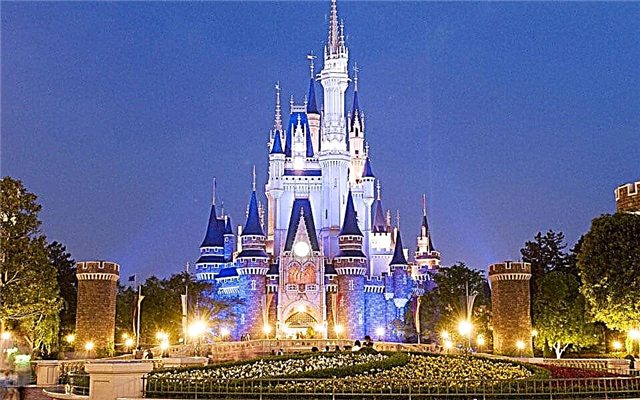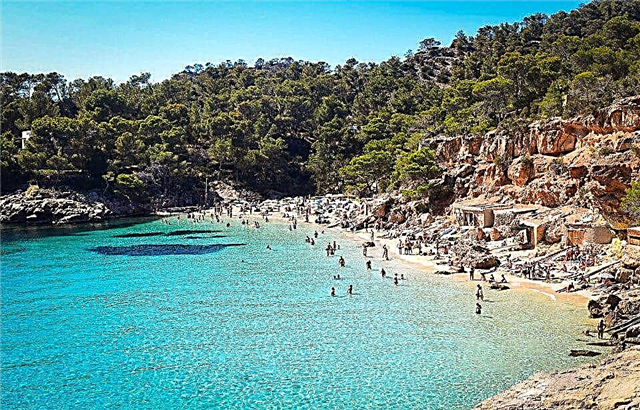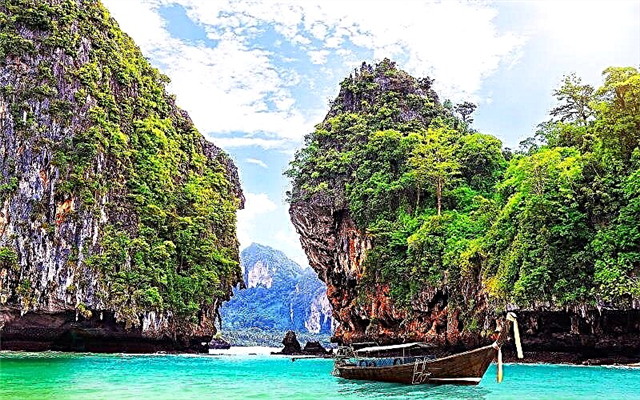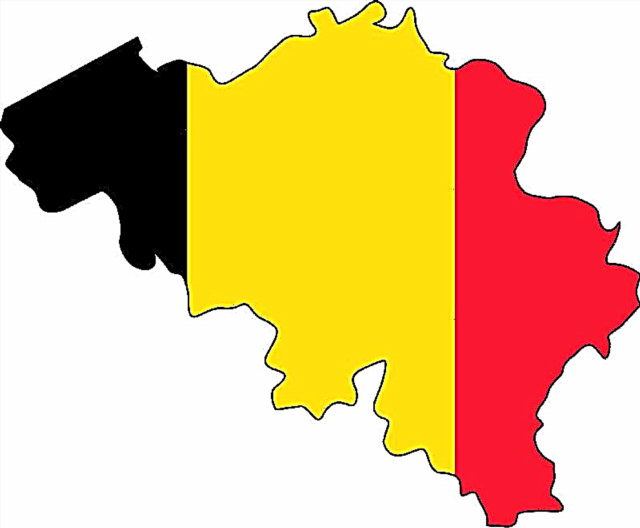Address: Moscow
First mention: 1535 year
Disassembled: 1931 year
Start of construction: 1994 year
Completion of construction: 1995 year
Project author: Petrok Maly Fryazin (1535), recreation - O.I. Zhurin
Coordinates: 55 ° 45'20.4 "N 37 ° 37'05.0" E
Content:
In the very center of the capital, next to Red Square, there is an architectural building of incredible beauty. The picturesque gate appeared in the first half of the 16th century, was destroyed in the early 1930s and rebuilt at the end of the 20th century. Today it is a popular pedestrian area. Every year hundreds of thousands of tourists pass under powerful stone arches and take pictures against the background of the Resurrection Gate.

View of the Resurrection Gate from the hotel "Moscow"
The history of the construction of the famous gate
The double gates appeared in 1535 and became part of a brick wall that stretches for more than 2.5 km around Kitai-Gorod. The construction of a powerful fortification took place at a time when Russia was ruled by the mother of Ivan the Terrible, Elena Glinskaya. And the construction of the fortification was carried out by the Italian architect and expert in fortification Petrok Malaya, nicknamed Fryazin.
At the very beginning, the two arches in the brick wall did not have any overhead. Two-storey towers above them appeared almost a century and a half later. At the same time, two pointed towers were decorated with double-headed eagles covered with gold.
Why the gate was called differently
The double passage in the Kitay-Gorod wall had different names. This is reflected in written documents and town planning plans. During the reign of John IV the Terrible, the section of the fortification ditch between Sobakina and Nikolskaya towers was not filled with water. There they kept cages with lions, which the Russian tsar received as a gift from England. The townspeople came to look at the outlandish animals and for a long time called the gate "Lions".
There was a time when the gates were called "Epiphany" by the nearby church. Under Father Peter I, the Trinity courtyard was located nearby, and the gates were named "Trinity". Until the 20s of the XIX century, there was a stone bridge connecting the two banks of the Neglinnaya River. Thanks to him, the gate was called "Neglimen".

View of the gate from the side of Red Square
In the history of the ancient gates, an unusual name has been preserved - "Kuretnye". Once near the Kremlin there was a poultry yard of the Kuretnaya Chamber, which was responsible for supplying the freshest chicken meat to the palace of the Russian tsars. Chickens in those days were called "chickens", and in written sources they sometimes wrote "kurets".
In 1689, an icon depicting the Resurrection of Christ was hung on the gate, after which the name "Resurrection" was assigned to them. It is noteworthy that the gates themselves gave the name to one of the central squares of the city. Until 1917 it was called "Voskresenskaya", and with the advent of Soviet power it received a new name - "Revolution Square".
Chapel
In 1669, a small wooden canopy was built near the gate, under which they began to store a copy of the Iberian Icon of the Mother of God revered by the faithful. Then, instead of a canopy, they erected an elegant chapel or, as they said then, a chapel.
At the end of the 19th century, a dilapidated wooden building was demolished, and instead of it, a stone chapel appeared at the gate, built according to the design of the famous architect Matvey Fedorovich Kazakov and the architect from Italy Pietro Gonzago. Since that time, many Muscovites and guests of the capital called the gates Iversky.

View of the gate of the Iverskaya chapel (in the center of the gate) from the side of the hotel "Moscow"
Gate in the XVIII-XX centuries
In 1737, the double gates were damaged in a fire. An experienced architect and master of Russian baroque Ivan Fedorovich Michurin was invited to restore them.
The two-storey gatehouse was used as a living room. In the second half of the 18th century, the famous Russian journalist and publisher Nikolai Ivanovich Novikov lived there, who was in charge of the nearby printing house of Moscow University.
According to tradition, all the men who passed under the Resurrection Gate to Red Square had to take off their hats, and before the entrance, the faithful were sure to kiss the Iberian Icon. People were constantly praying in the chapel. True, it was small and could accommodate no more than 50 people. It is noteworthy that the Iberian icon was revered not only by the Orthodox. Catholics who came to the city also came to bow to her.
The invasion of French troops severely ravaged the city. After the enemy left, the restoration of the gate and the chapel was entrusted to the Russian architect and great lover of pseudo-Gothic Alexei Nikitich Bakarev. Muscovites liked the restored chapel very much and began to be perceived as a monument to the victory over Napoleon.
In the fall of 1917, real street battles took place in the area of Voskresenskaya Square. The troops, loyal to the old regime, used the Resurrection Gate as a line of defense and tried to keep the Bolsheviks out of the Kremlin walls. However, the history of the country has already taken a sharp turn, the power in the state has changed.

Gate towers
In the 1920s, the talented restorer Pyotr Dmitrievich Baranovsky supervised the major restoration of the Kazan Cathedral, the chapel and the Iberian Gate. The restorers have done a great job trying to restore the original image of the old buildings. They restored the picturesque carved architraves on the gates, but they could not complete what they had begun.
The fate of the old monuments near the Kremlin was already a foregone conclusion. The Moscow leadership announced its plans to use Red Square for military parades, physical education processions and popular demonstrations. The Voskresensk gate was in the way, because it blocked the passage for transport. In addition, the religious buildings did not fit into the new Soviet ideology in any way, so it was decided to destroy the gates, chapel and cathedral.
The praying chapel was dismantled in 1929, and a pretentious statue of a worker was erected in an empty space. The gate did not last long. They were demolished two years later, and the passage was renamed Historical. For several decades, pedestrian columns of workers and sportsmen, as well as military equipment, passed unhindered along the cleared path to the main square of the country.
In the mid-1990s, the Moscow government came up with an initiative to restore the lost historical monuments. The construction work was supervised by Oleg Igorevich Zhurin, a pupil of P. D. Baranovsky. The construction of a replica of the stone gate and a small chapel took two years and was completed in 1995.
Then the passage of the Iversky Gate was turned into a pedestrian zone, and traffic was prohibited on it. Since 2008, cars and equipment for parades have come to Red Square along the Kremlin passage, which is closer to the Kremlin.

Resurrection gate in the night illumination
Architectural features
The ancient gates fit perfectly into the space dividing the massive building of the State Historical Museum and the Old City Duma, and together with them form a harmonious architectural ensemble. Two faceted green tents, as in the past, are crowned with gilded double-headed eagles.
The restored gates are painted in dark red, and the decorative elements - platbands, columns and belts are highlighted in white. This makes the building elegant and festive. Drawings and postcards from the 19th century and early 20th century show that this was not always the case. Earlier, the Resurrection Gate was white.
Resurrection gate today
The passage at the Resurrection Gate has long become one of the most popular promenades in the capital. Muscovites and tourists love to walk along the neat pavements and admire the pseudo-Russian facades of buildings. The small Iverskaya chapel stands exactly in the middle between the arches from the side of Manezhnaya Square. Pedestrians pass under one of the gate arches, while the other is almost always covered with a metal grill.
Near the gate there is a popular tourist attraction - Kilometer Zero of Russian Highways. There is a tradition to mark a symbolic place from where distances are kept in many countries of the world. Such a monument appeared in Moscow in 1995. The bronze sign was made under the direction of the sculptor Alexander Rukavishnikov and mounted on the cobblestone pavement. It is made especially for tourists. The real zero kilometer is located near the building of the Central Telegraph, located on Tverskaya Street, 500 meters from the Resurrection Gate.

Double-headed eagle on one of the gate towers
How to get there
The architectural monument is easily accessible on foot from the Teatralnaya, Ploschad Revolyutsii and Okhotny Ryad stations of the Moscow metro.











